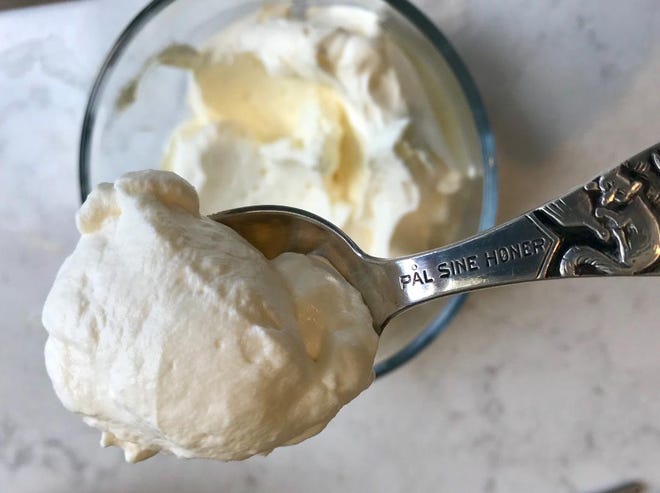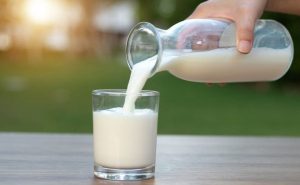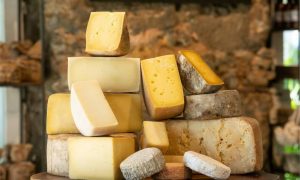That’s thanks in part to redeeming reports of full-fat dairy in a healthful diet combined with all the cooking and baking we’re doing during the pandemic.
As of mid-July, cream sales by volume in the United States have jumped 23% over the same period in 2019, to nearly 37 million pints, according to Lizzie Duffey of the Dairy Farmers of Wisconsin. Sales of half and half are up nearly 9% in the United States so far this year.
In Wisconsin, the jump is more dramatic. Sales of cream have reached 126,000 pints in 2020, up a whopping 38% compared with the same 28-week time period in 2019, Duffey noted.
It’s a trend that’s been building. Cream sales have steadily increased over the past five years, topping more than 58 million pints in 2019, an increase of more than 5% over the year before, Duffey said.
The coronavirus pandemic has prompted a “comfort food boom” as people are at home cooking and baking, said Suzanne Fanning, a senior vice president for Dairy Farmers of Wisconsin.
“People are gathering around the table with their family, and they are looking for comfort food recipes, many of which include delicious Wisconsin cream,” she said.
She added that consumers and home cooks are appreciating the benefits of full-fat dairy in general. “When it comes to flavor and texture, real all-natural cream makes a huge difference,” she said.
It all starts on the farm
Long before most are reaching for the cream to pour into their morning coffee, dairy farmers all over Wisconsin are up and milking their cows. It’s rise and shine . . . and milk.
The Travis and Stephanie Tranel family in Grant County is just one example.
Working their USDA-certified organic dairy farm in the Driftless Area of Wisconsin, they produce milk for food coop Organic Valley, based in La Farge. Stephanie also makes and sells Tranel Family Farms Soaps, sold in 16 states.
But their main focus is organic milk from pasture-raised cows.
“The milk truck comes every morning to pick up,” said Stephanie, a self-described city girl from Iowa who married a sixth-generation Wisconsin dairy farmer. “We start our first milking about 4:30 in the morning.”
Their cow breeds are a mix of mostly Holstein, Red Holstein, Brown Swiss and Jersey. The Holsteins provide a large volume of milk, while the gentle Brown Swiss and Jersey are known for their high-fat milk, she explained.
“We raise our animals with care and compassion,” she said.
Many years ago some of Travis’ ancestors immigrated from Germany to farm in Wisconsin, while others stayed in Germany and are still working their farm there as well, according to Stephanie.
“Farming is a lifestyle for us. It’s not an occupation,” she said. “It’s in our blood.”
Eating the right amount
While cream has no significant nutritional value, it is a fat, and with any fat, portion size is key, said Karen Krchma, a certified registered dietitian, nutritionist and owner of New-Newtrition in Thiensville. Guidelines for fats have changed from just a few years ago, after low-fat substitutes failed to deliver on health claims.
“My research shows that full-fat dairy can be a great choice with the caveat that one follow daily recommended servings,” she said.
“When you’re in the grocery store aisle deciding whether to choose low or full-fat products, I encourage my clients to read the nutrition labels. Low-fat foods can contain additives, stabilizers and sugar to create a taste and mouthfeel like fat. It’s important to always make your choices as part of a well-balanced diet,” she said.
Fats such as cream help eaters feel more satisfied.
“The choice of whole-fat dairy can positively affect cholesterol levels, maintain a balance of blood sugar, especially for pre-diabetes and diabetes, as well as increase the satiety levels of meals, therefore positively influencing weight management,” Krchma explained.
Plus, a little whipped cream is a treat.
Adding a dollop of whipped cream to summer’s fresh fruit turns it into dessert. Berries, especially with unsweetened whipped cream, could be a far healthier, lower-calorie choice when compared with other dessert choices.
The real deal
When evaluating cream and imitation products, be sure to read the list of ingredients.
For example, Organic Valley’s ultra-pasteurized cream contains organic Grade A cream and gellan gum, according to its label.
Cool Whip Original, a dessert topping produced by the Kraft Heinz company, is much different. It includes water, corn syrup, high fructose corn syrup, hydrogenated vegetable oil, skim milk and less than 2% light cream, sodium caseinate, natural and artificial flavoring, xanthan and guar gums, modified food starch, polysorbate 60, sorbitan monostearate, sodium polyphosphate and beta carotene.
Another product, canned Reddi-whip made by Conagra, lists cream first on its label (though not listed as heavy cream; if you want that higher milkfat option, consider the extra creamy version). But, it also contains water, sugar, corn syrup, non-fat milk, mono- and di-glycerides, natural flavor and carrageenan. It also uses nitrous oxide, a mixing and foaming agent, as a propellant, according to the label on its original formula.
Pick the right cream
To help food shoppers and home cooks, Amy Thieding, culinary and consumer marketing manager at Dairy Farmers of Wisconsin, offered some helpful definitions to understand the dairy options that relate to cream.
- Sour cream will contain a minimum of 18% milkfat. Cultured sour cream, the most common type, is fermented and thickened by adding lactic acid bacteria to pasteurized cream. This gives it a tangy flavor.
- Light cream contains 18% to 30% milkfat. It adds richness to salad dressings or can be drizzled over soups, fruits, desserts and breakfast cereals hot or cold. However, it won’t stand up when whipped.
- Whipping cream contains 30% to 36% milk fat. “And like the name implies, this cream can be used to make whipped cream, but it won’t be as stable, or hold its shape, as one made with heavy whipping cream,” Thieding said. Use this cream for recipes for pasta sauces, soups and desserts.
- Heavy whipping cream is the gold standard for holding its peaks. It’s easily whipped and the best choice when making whipped cream, toppings or folding into recipes. Milkfat is from 36% to 38%.
- Clotted cream contains at least 55% milkfat. “Rich and lightly sweet, the cream is indirectly heated for hours and upon cooling the rich cream rises to the top and thickens or clots,” Thieding explained.
- Not technically cream but related and interesting to note: Half and half is a blend of whole milk and light cream with 10.5% to 18% milkfat. This is preferred by many with coffee or breakfast cereal, including baked oatmeal.
- Ice cream contains a minimum of 10% milkfat from milk, cream or both. The milkfat gives ice cream its smoothness and rich mouthfeel.
“Cream is so versatile and a staple ingredient in many types of recipes,” Thieding said. “Consider adding cream to recipes when you want to add lovely creaminess to sweet and savory sauces, soups, salad dressings, macaroni and cheese, frosting or decadence to egg dishes, mashed potatoes, baked goods, chilled desserts and homemade ice cream.”
Thieding recommended choosing whipping cream or heavy whipping cream when cooking with hotter temperatures. “When cooking with cream, keep in mind that creams with higher milkfat are less likely to curdle when heated, boiled or added to hot ingredients,” she said. “For dishes with shorter cook times and lower heat, such as scrambled eggs, light cream may work in those recipes.”
For more than 50 recipes calling for cream ranging from butternut squash Parmesan pasta to Asiago broccoli soup, see wisconsincheese.com.
What is cream?
Cream is the fat from the milk of cows that have recently given birth. In fresh milk straight from the cow, cream will naturally rise to the top if left undisturbed.
To be called cream, it must have at least 18% milkfat, said Duffey, of the Dairy Farmers of Wisconsin.
In comparison with other common dairy products from cows, most U.S. butter is 80% or 81% fat. Whole milk is usually homogenized to a milkfat content of about 3.25%.
Cream will typically be available at stores as either pasteurized or ultra-pasteurized. Ultra-pasteurized means it has been heated to a higher temperature in production than pasteurized and will have a longer shelf life prior to opening. Ultra-pasteurized cream may contain additives; check the ingredients label.
It’s helpful to know the terms milkfat and butterfat are the same thing. Older cookbooks may refer to it as butterfat, while recent recipes may use the more-common term milkfat.













